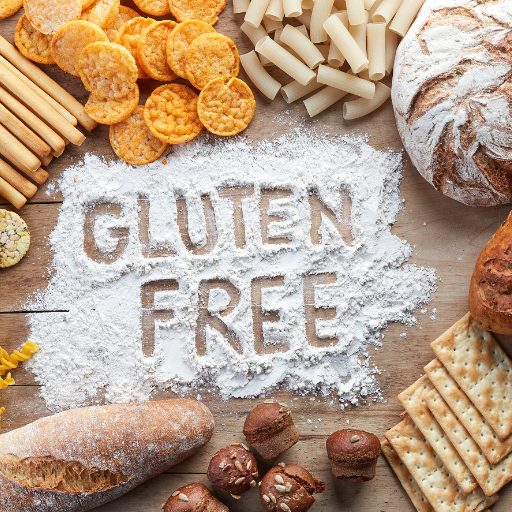From firsthand experience, I am going to share my affordable gluten-free cooking and baking tips. Learning was not a choice. The pain from my inflammation grew weekly. Despite milling grains for non-yeast bread, growing most of our food, and even eating beef from pasture-raised cows, my daughter suffered from induced rheumatoid arthritis. Speechless, I listened to the doctor emphasized the importance of removing gluten and casein, milk protein, from my diet. Surprisingly, it took me years to learn how to once again affordably feed our whole family the same meal. I was so accustomed to pain that I will never forget the morning I woke up pain free. Undeniably, the journey is worth the effort.
Invisible Effects of Food Intolerance
An allergic reaction to a bee sting is easy to spot because the inflammation is visible. Food, on the other hand, can cause inflammation in places we are unable to see with our naked eye. For example, inflammation inside the eustachian tubes can cause an ear infection. Ulcerative colitis occurs when there is untreated inflammation in the intestinal tract. Enlarged adenoids can trap a food allergen. Thus, inflammation occurs in the throat and eustachian tubes. Thankfully, we can feel the change with middle ear discomfort. Unfortunately, little ones often fail to share that a particular food makes them feel uncomfortable. However, their behaviors usually fluctuate according to how much of the food irritant was eaten. Bloating, stomach aches, and mood swings are all be indicators of a food allergy or intolerance.
While food allergies tend to occur rather quickly, food intolerance occurs slowly. Food intolerance typically invokes a response about 12 hours after ingestion. When a food intolerance affects behavior, what is eaten the day prior affects behavior today. Because of the delayed reaction, the inflammatory food is easily ingested multiple times. Thus, multiplying the effect on behavior. For example, milk exposure often occurs during breakfast with cereal. Again, at lunchtime with a grilled cheese sandwich. Next, while eating ice cream for a snack. Lastly, during supper with Alfredo sauce and noodles. Imagine the effects on behaviors like attention and patience. A little child who is sweet one day, and a hitter the next day, may be acting out due to a food intolerance.
Top 6 Inflammatory Foods
The top 6 inflammatory foods contributing to inflammation of the eustachian tubes are dairy, eggs, chocolate, nuts, sugar, and wheat. Gluten is a component of wheat. When you eliminate wheat, you should also avoid gluten. If you have an unknown food allergy or intolerance, it causes inflammation throughout your body. Unknown inflammation results in a domino effect: disrupted sleep, increased irritable behaviors, decreased attention, and difficulty hearing. All of these negatively affect learning and social behaviors.
Rotate Foods
Rotating foods helps to decrease inflammation and minimizes the risk of developing a food intolerance. Researchers have found that small exposures to a food intolerance with weeks of no exposure slowly improves one’s tolerance. This is not true with food allergies, which are a DNA genetic response. You start by removing the one or two suspected foods from your diet for at least a month. During this time, talk to your doctor about allergy testing. It takes about a month for the body’s inflammation to subside. Then, rotate one of the eliminated foods back into your diet to see if there is a reaction. This post focuses on removing gluten from your diet. Be encouraged, the benefits are health improvements and energy. Like us, you may enjoy the textures and taste of our delicious recipes.
Going Gluten Free: Intimidated?
Going gluten-free sounds intimidating. What do you eat? It seems as if everything has gluten in it when you start this journey. Thankfully, you can learn from my family’s journey and avoid some disastrous gluten-free meals endured by my children.
My family began our gluten free journey in 2013, when my daughter was diagnosed with an IGG severe gluten-intolerance and casein-intolerance. So severe the doctor told us to treat it like an allergy to resolve my daughter’s induced-rheumatoid arthritis. At that time, there were limited gluten-free products available in grocery stores. Unfortunately, I first experimented with breads made with all sorts of rice flours full of high-sugar index flour and awful textures. It was so bad; I gave up on sandwiches. My daughter started taking leftover meat or lunchmeat without any sandwich bread for school lunches.
Luckily, I always enjoyed experimenting with different recipes. Thus, I took up the challenge of learning about different gluten-free flours. Then, I decided to eliminate yeast and tweaking my favorite recipes. The expanse of gluten-free flours motivated me to look for answers. I found them! I bought a grain mill and gluten-free, organic, whole grains! When you mill your own grains, your flour is full of nutrients like amino acids, healthy oils, and fiber.
Today, there are many tasty gluten-free brands available in local grocery stores. Even Walmart! You are often able to find a complete gluten-free section filled with box mixes, loaves of bread, cookies, and flours. However, pre-packed foods are unable to compete with the nutritional quality of fresh baked goods and breads. They are also expensive.
Why Remove Gluten from Your Diet?
Removing gluten from your diet reduces inflammation and pain. Why? Because, gluten is difficult for our digestive system to break down. Alarmingly, gluten can cause inflammation anywhere in the body, including the ears, nose, and brain. Inflammation in the ears or nose decreases hearing. Unfortunately, decreased hearing and inflammation in the brain negatively affects behaviors and brain development in preschoolers and children. After removal of gluten, I have seen significant improvements in clients’ behavior, speech fluency, and focus.
Have you ever thought about the importance of maintaining brain health? Surprisingly, adults who remove gluten experience clearer thinking, less brain fog. Remember, removing gluten decreases inflammation everywhere, including the brain. Do your ears sometimes feel stopped up or uncomfortable from pressure? If so, you may have inflammation in your Eustachian tubes. Thus, sounds are not strongly stimulating your cochlea, your brain. I call this temporary hearing loss. Unfortunately, chronic inflammation contributing to even chronic, mild hearing loss can cause a decline in cognitive functions and emotional health. The video, Effects of Diminished Hearing, shares a research study from John Hopkins. Amazingly, they tracked older adults for over ten years.
How To Stay Healthy While Eating Gluten-Free
The healthiest way to eat gluten-free is to focus your meals around foods that are naturally gluten-free. Not only will it create a nutrient-dense meal, but it will also be the most cost-effective. When you remove gluten from your diet, you are removing natural and enriched sources of iron, calcium, fiber, thiamin, riboflavin, niacin, and folate. Replacement gluten-free breads and cereals will have different nutrient levels than the original product. Not all gluten-free products are healthy. Nutrition labels may show higher fat and sugar than foods containing gluten. When you mill your own grains or buy organic, non-GMO gluten free flour, you are actually eating healthier.
Affordable Gluten-Free Alternatives
Prepared gluten-free products are convenient, but they are costly. To make this diet affordable for the whole family, look for naturally gluten free foods rather than gluten free replacements. For example, tacos are a wonderful, easy to make, delicious, and naturally gluten free meal. Mix up your own seasonings and serve your taco meat on soft corn tortillas, corn hard shells, or over corn tortilla chips. You don’t have to buy expensive gluten free wraps in place of soft flour tortillas. Corn tortillas while small in size work wonderfully!
If you love breads and baked goods, I highly recommend investing in a grain mill. Milling your own grain gives you highly nutritious flour that you cannot buy in a store. In order to make flour shelf stable, the bran and germ of the kernel is removed which contains over 30 nutrients. When you mill, you are literally eating living bread full of protein, healthy fats, essential amino acids, and fiber. Make sure you buy organic, Non-GMO grains.
Because the flour still contains all the nutrients in the kernel, it becomes rancid very quickly. Store freshly-milled flour in an airtight container in the refrigerator for two weeks. Milled flour last about three months in the freezer.
Here are a few grain mills my family has personally tested:
How to Source Safe Gluten-Free Products
Look for certified gluten free products. You will often see the initials “GF” on certified products. Certified products contain no gluten and are safe from cross-contamination. If you are allergic or have celiac disease, it is very important to buy certified gluten free products to avoid a cross-contamination allergic reaction.
However, not all gluten-free products will have a GF label. Fresh fruit and vegetables are naturally gluten free. One product that is naturally gluten-free is oats. However, cross-contamination occurs when the same equipment is used with gluten-full grains. For example, when oats are harvested using the same tractor grain head that harvested gluten-full wheat, oats become cross-contaminated with gluten. Thus, if you are allergic to wheat or gluten, look for certified, gluten free oats.
Personally, I enjoy Red Bob Mill’s gluten-free products. They offer a variety of gluten-free, organic, non-genetically modified flours. Trying out their different flours is a great way to learn what you like before you purchase grains in bulk.
Affordable Gluten Free Cooking Tips
Frying
There is a bean-based gluten-free baking flour by Bob Red Mills, garbanzo bean, which fries up nicely. (Don’t bake with any type of bean-based gluten free flour.)
Sauces
Sauces are a great way to elevate a meal and add more flavor. Recipes for homemade sauces typically have the same base ingredients that are affordable to make a kitchen staple. They are also quick to make!
Seasonings
Investing in seasonings can be expensive on the front end, but they last for months and remove the need to buy individualized seasoning packets. Slowly build your seasoning cabinet to keep it affordable and create delicious meals. I suggest starting out with:
I Suggest Starting With:
- Garlic powder
- Paprika
- Onion powder
- Herbs de providence
- Oregano
- Chili powder
- Cumin
Later You Can Add:
- Basil
- Thyme
- Ginger
- Rosemary
- Curry
Oils
When preparing fresh foods, you will need to have oil on hand. The two oils I reach for the most are extra virgin olive oil and coconut oil. Oils are another item that you have to invest in upfront, but it will last for a few months.
Affordable Gluten Free Baking Tips
Pancakes
Use buckwheat by itself or ½ buckwheat flour mixed with ½ GF all-purpose baking flour, you can buy the groats and mill yourself.
Cornbread

I dislike the texture of the GF mixes. I use my favorite recipe using half cornmeal and half gluten-free all-purpose flour. Organic cornmeal mixed with flour works ok for frying but is a bit grainy. Steiger Family Farms has a great Gluten and Dairy Free Cornbread Recipe.
Cooking Time
Cooking time often takes longer with gluten free breads like banana bread. If you are using a conventional recipe and substituting the flour for a gluten free alternative, always check with a knife to see if it is done.
Add Benefiber
Bake with Benefiber when using all-purpose gluten free flour. All-purpose gluten-free flour is typically high in sugar and caused my sugar to spike when I ate my baked goods. Once I started adding fiber to the recipe, my sugar levels were much better.
A Blessing in Disguise
Our family’s struggles with food intolerances and allergies have been a blessing in disguise. We learned about the nutritional benefits of different grains like amino acids and healthy oils. Buying grains in bulk greatly reduced our grocery budget. Repurposing leftovers resulted in financial savings and more diverse, healthy lunch choices. Most significant, I became aware of the importance of looking for grains that were Non-GMO and organic. I thought all organic foods were Non-GMO.










0 Comments